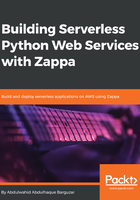
上QQ阅读APP看书,第一时间看更新
Building, testing, and deploying a Python web service using Zappa
We are going to create a simple hello world program as a microservice using Python's Bottle framework. Let's follow some basic steps to configure a small project using the Bottle framework:
- First, we will create a new project directory named lambda_bottle_poc:
$ mkdir lambda_bottle_poc
- Let's create a virtual environment inside the lambda_bottle_poc directory:
$ virtualenv env -p python3.6
- Here is the basic hello world program using the Bottle framework:

Now it's time to deploy the program as serverless on AWS Lambda and expose the /hello API via API Gateway. In the previous chapter, we described the manual process to deploy the Python application, using AWS console and AWS CLI, which was a really big challenge.
But with the help of Zappa, all manual processes of the AWS console and AWS CLI are automated and provides a rapid process to deploy and maintain your application in a serverless environment.